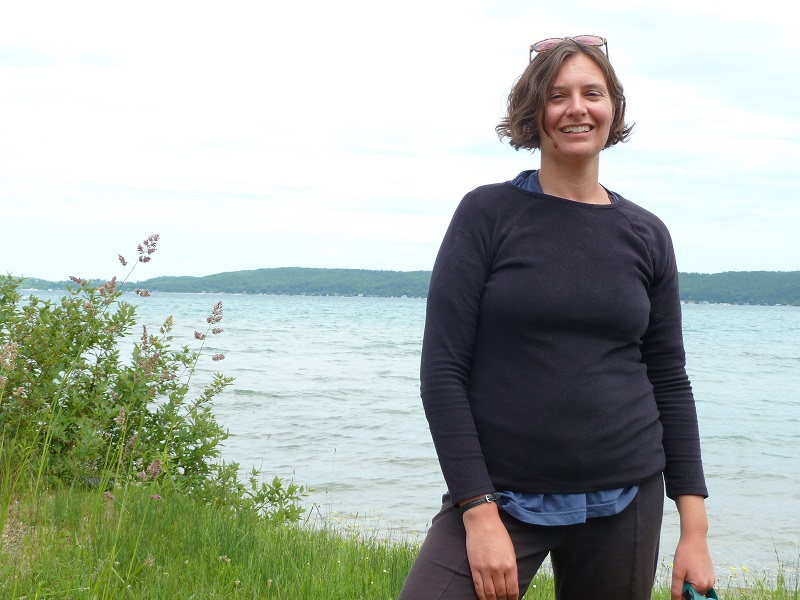Contributor Spotlight: Stephanie Heit
 Stephanie Heit’s piece “Lake Etymology” appears in Midwestern Gothic Issue 18, out now.
Stephanie Heit’s piece “Lake Etymology” appears in Midwestern Gothic Issue 18, out now.
What’s your connection to the Midwest, and how has the region influenced your writing?
I was raised amphibious dividing my time between suburban sidewalks and the shores and waters of Lake Michigan and Crystal Lake. Forest floor and sand dune textures harden my bare feet. The humidity of summers that flap book covers open I carry in my bones. Nasal Midwest accent inherent in spite of decades in other places. My writing is created out of my body imprinted with the rhythms of dune grass and fern and tide.
What do you think is the most compelling aspect of the Midwest?
The sand yields to my feet on a warm late afternoon as I walk my favorite beach. Sea gulls and white caps play the surface. There is no one around, just sand and blue and my desire to swim. I strip and enter the waves enveloping my body in a water dance. I emerge refreshed and walk without a trace, footprints filled by the rising tide.
Also, Midwest sarcasm.
How do your experiences or memories of specific places—such as where you grew up, or a place you’ve visited that you can’t get out of your head—play a role in your writing?
Root system and bone marrow, my beloved Up North acts as barometer and baseline. Place of refuge I return to for retreat or to do intensive work on a writing project. Sometimes I think memory/bodily sensation of place plays an even more influential role in my writing when I am in other locations. I lived in Boulder/Denver, Colorado for over a decade and, though I adored my beautiful community, never felt at home. The high dry desert landscape increased my hunger for water and green infiltrating my writing with trillium and morel realities as lullaby to Midwest lust.
And I love to travel. All this talk of Midwest origin and longing feels like I’m giving a faulty stationary impression. When I taught and lived in Chile I reveled in the discomfort and delight of finding my way in unfamiliar spaces. Breathing in a new language broke open aspects of myself that thrive in Spanish. Witnessing other worlds and ways of being awakens my perception.
Discuss your writing process — inspirations, ideal environments, how you deal with writer’s block.
My first language is movement with my writing an attempt to inscribe the body on the page. My writing practice lives alongside and within art practices that hone my awareness such as improvisation, contemplative dance practice, authentic movement, kundalini yoga. I delight in collaboration with other artists and between forms. Ideal environments include the hardwood floor of a dance studio between movement explorations, on a dock after a swim, in an art museum, writing sitting next to someone writing. I love the kinesthetic quality of longhand and write first drafts in pen and paper. For revision, I am located at my purple desk working on the computer. In regards to writer’s block, I live with bipolar disorder where changing levels of energy, concentration and desire define my practice. I’ve expanded my definition of a writer to include those times when I’m unable to read or write. Sometimes the writing process is not about actual writing but an artful way of being in the world.
How can you tell when a piece of writing is finished?
When it breathes without me.
Who is your favorite author (fiction writer or poet), and what draws you to their work?
Writing for me is about the unknown, discovery and surprising myself – all qualities I look for in my favorite work. Movement and a sense of embodied poetics is also a common theme in my loves. Notice the plural. I’m poly when it comes to literary relationships. Carole Maso. Jeanette Winterson. Olga Broumas. Erin Mouré. June Jordan. Simon Van Booy. Larissa Szporluk. Anne Carson. My bookshelves are stacked with my own changing reading history. I go through phases and waves of passion. I’m in love with my longterm writing community. Max Regan. Claudia F. Savage. Joanna Preucel. Gabrielle Edison. Debra Horowitz. It is often highlighted how solitary writing is, but I find it is quite a crowd between the authors and writers I am in dialogue with on the page or in person.
What’s next for you?
I’m in the process of finding a home for my poetry collection, The Color She Gave Gravity, which enacts longing for connection between women that takes us inside a dance inside an imaginary city inside sculpted spaces inside the insomniac body inside sister grief inside she.
This summer my partner, community artist Petra Kuppers, and I have been practicing the curriculum from Andrea Olsen’s book Body and Earth. The exercises are a mix of experiential anatomy, poetry of place, writing and somatics. This week we are doing daily 5 minute dances followed by writing in different locations. Yesterday we danced in the lake. We travel to London in July to continue our asylum collaborative inquiry in a week of workshops exploring multiple meanings of “asylum:” from asylum seekers and the limits of Empire, to psychiatric asylums and queer sanctuary space, to temporary places of security and refuge. This project is part of the Olimpias (www.olimpias.org), an artists’ collective directed by Petra that creates collaborative, research-focused environments open to people with physical, emotional, sensory and cognitive differences and their allies.
I’ve always dreamt of writing a book you could read inside your body. I’m planning an attempt soon.
Where can we find out more about you?
Feel free to send me a note: stephanieheit@gmail.com






